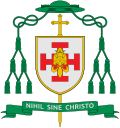Buildings
Moor Park is one of a group of country houses in the Ludlow district linked by one family, the Salweys. Haye Park, located in the Mortimer Forest, is the oldest of these buildings and was built by Richard Salwey in the mid-1600s. The Salwey family lived at Moor Park until 1870. Edward VII, then the Prince of Wales, paid the estate a visit with the intention of buying it as a country estate. He eventually settled on Sandringham House in Sandringham, Norfolk due to its proximity to the nation's capital London. Major Johnston Foster bought the estate in 1874 and proceeded to construct a new building around the Queen Anne house, incorporating the latest architectural trends of the day. His eldest daughter Ethel Jane Foster married Irish nobleman Lucius O'Brien, 15th Baron Inchiquin and they spent some time living at Moor Park, but chose to move to Ireland instead. Members of the Salwey and O'Brien families still reside in the area.
From then, Moor Park's tenants were mostly schools. During World War II, Lancing College evacuated to Moor Park from West Sussex to escape impending air raids. One notable Old Lancing from this era is novelist Tom Sharpe. His novel Blott on the Landscape was loosely based on Moor Park and the Foster family. After Lancing College returned to its original site, St Margaret's School was founded at Moor Park by Miss Nugent-Thorpe of the Parents' National Education Union (PNEU), and continued until her retirement in 1962. In 1964 the estate was bought by Hugh Watts and Derek Henderson and became the present-day school. [5]



